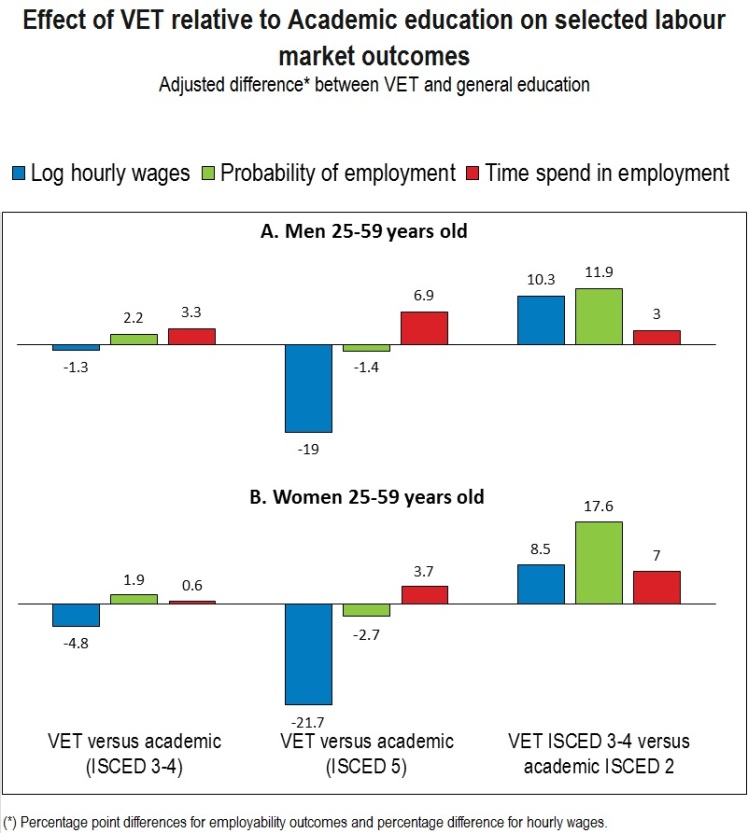By Glenda Quintini.
Vocational education and training are highly valued by many. In 2010, the European Ministers for Vocational Education and Training, the European Social Partners and the European Commission issued the Bruges Communiqué, which describes the global vision for VET in Europe 2020. In this vision, vocational skills and competencies are considered as important as academic skills and competencies. VET is expected to play an important role in achieving two Europe 2020 headline targets set in the education field: a) reduce the rate of early school leavers from education to less than 10 percent; b) increase the share of 30 to 40 years old having completed tertiary or equivalent education to at least 40 percent.
But just how good is VET compared to general education in getting people into well-paid jobs? Unfortunately, the few existing studies yield mixed results partly due to differences in the structure and quality of VET across countries. The new study “The effects of Vocational Education on adult skills and wages. What we learn from PIAAC?” by Brunello and Rocco (2015) released today addresses precisely this question by using the Survey of Adult Skills (PIAAC). Data comparability across countries, the breath of countries involved, and the almost unique presence of information on assessed skills, training, earnings and employment makes this survey especially valuable to study the different facets of VET as compared to more academic education.
The first problem to solve when approaching the question of how good VET is for employability is to decide what it should be compared to. In the study, the choice is made to compare VET outcomes to the outcomes of general education at the same qualification level. Other choices are possible, depending on the answers sought. Same-level comparisons are ideal to provide direction on where government should invest in the education system. In addition, as VET is regarded in many countries as an option for students failing in general education, a straight comparison would capture the effect of different initial ability of students rather than the actual effect of VET courses. For this reason, the study uses a novel approach to attempt to isolate the two effects. Tests suggest that the technique employed allows getting closer to the true effect of VET on labour market outcomes.
The findings are encouraging in some ways while disappointing in others. Overall, at the high school level, the study finds that VET performs about as well as academic education as far as earnings are concerned and a bit better in terms of employment outcomes. VET at the high school level is also associated with higher training incidence. Finally, the findings support the view that the presence of vocational tracks helps keeping students with limited academic attitudes in school. On the other hand and despite the emphasis put on creating and/or expanding VET opportunities at the tertiary level, we find a clear advantage of academic education at this level across most of the outcomes considered.
More specifically, at the high school level (ISCED 3-4), a vocational curriculum is associated to only slightly lower hourly earnings but a higher probability of being currently employed, and a higher share of the completed working life spent in paid employment. The estimated differences are small: for earnings, the negative gap ranges between -1.3 percent for males and -4.8 percent for females; for the probability of employment and the share of time spent in paid employment, the estimated positive gaps are 2.2 and 3.3 percentage points for males and 1.9 and 0.6 percentage points for females.
On the other hand, the comparison between vocational and academic education is much more disappointing when we consider tertiary education (ISCED 5). In this case, the earnings gap between vocational and academic education at the time of the interview is as big as -19 percent for males and -21.7 percent for females. There is also a small negative gap in the probability of being currently employed. This gap should however be contrasted with the positive gap in the share of the working life spent in paid jobs, estimated at 6.9 percentage points in the case of males and at 3.7 percentage points in the case of females.
The study also compares the labour market outcomes and the current skills of individuals who have completed high school level or post‑secondary level vocational education (VET ISCED 3-4) and individuals who have completed at most lower secondary education (academic ISCED 2). It is often said that the presence of vocational tracks helps keeping students with limited academic attitudes in school. The empirical evidence shows that high school VET is associated with substantially higher hourly earnings and employability with respect to lower education. For males, we estimate an hourly earnings premium of 10.3 percent and an employment premium of 11.9 percentage points. In spite of spending more time at school than the latter, the former also end up spending a higher percentage of time in paid employment.
Overall, the evidence we have on different education levels suggests that vocational education does not perform as well as academic education when earnings are concerned, and performs slightly better than academic education when employability measures are considered. Unsurprisingly, there are large cross-country differences, most likely explained by differences in the quality of VET instructions. For instance, there is evidence that the wage and employment returns to VET are higher in countries where the relative supply of VET graduates is lower. In these countries, skill performance by VET graduates is also better. However, in spite of the growing interest attracted by dual systems, which alternate school and work, the study does not find systematic evidence that returns to VET are higher in the countries where vocational education systematically combines school and work.
Photo Credit: Clipart images from http://www.bing.com


3 thoughts on “Employability: Is Vocational Education Better?”